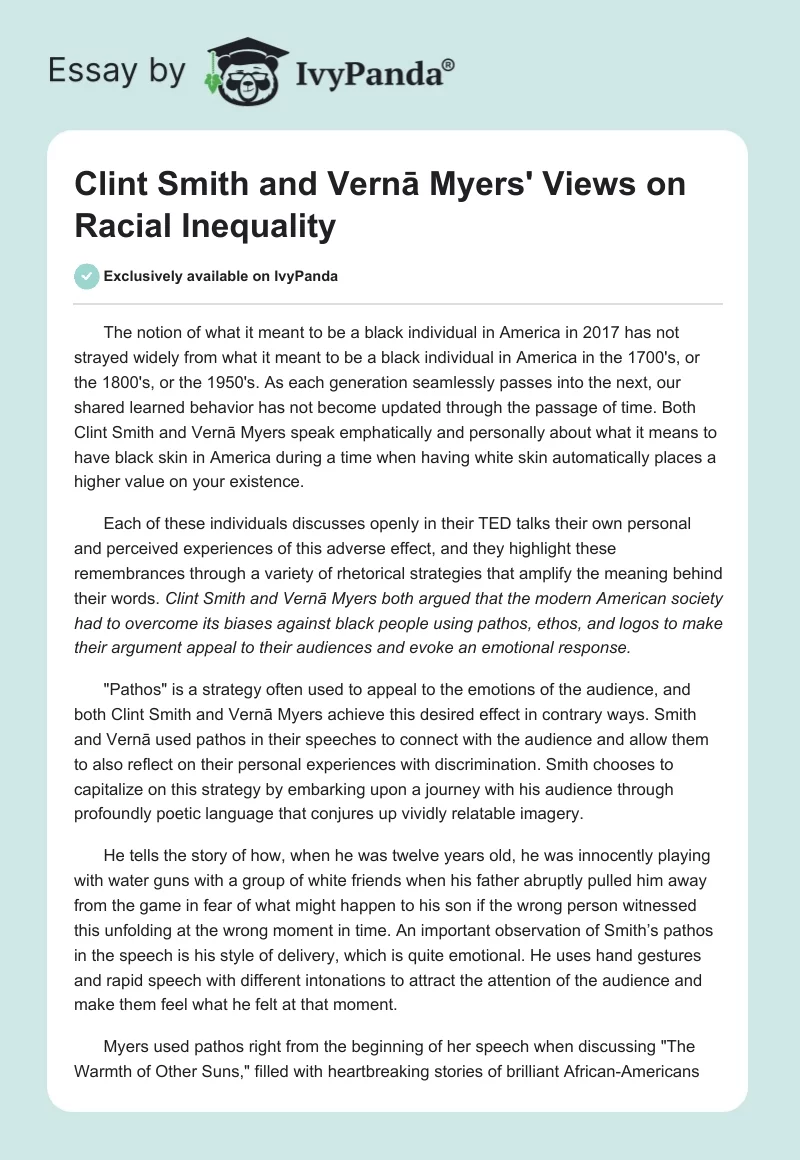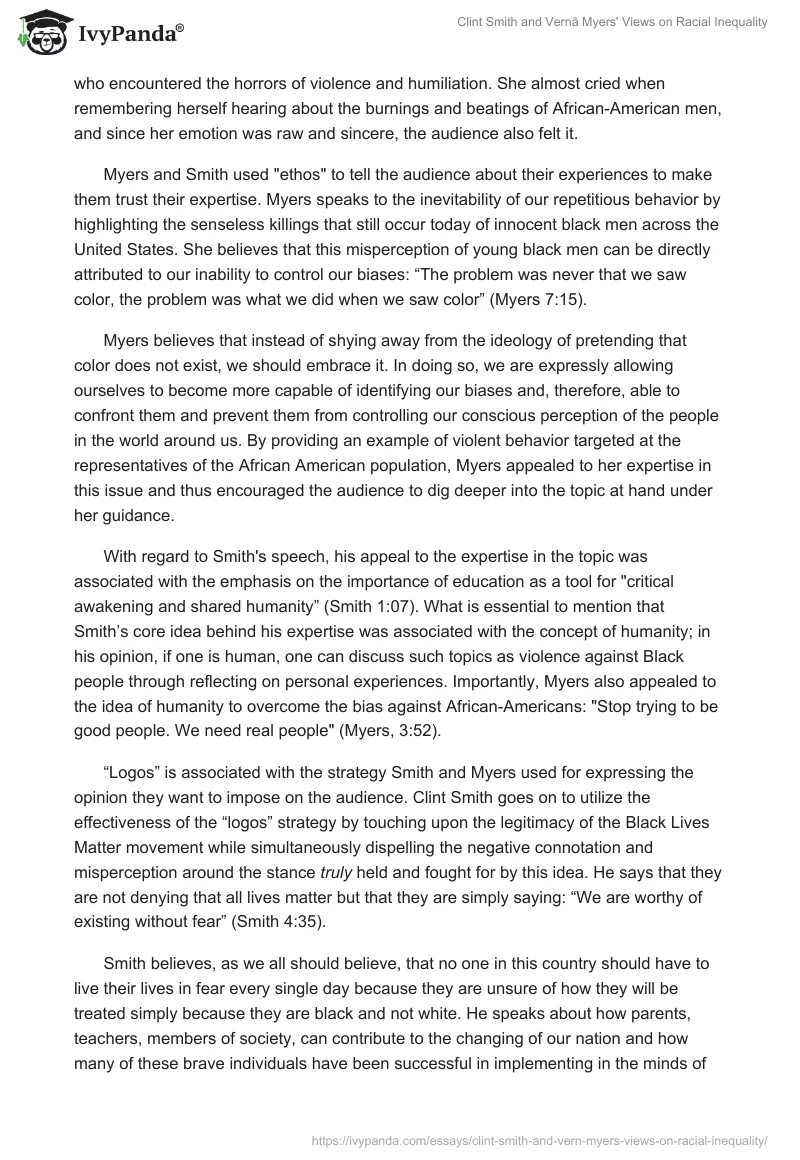The notion of what it meant to be a black individual in America in 2017 has not strayed widely from what it meant to be a black individual in America in the 1700’s, or the 1800’s, or the 1950’s. As each generation seamlessly passes into the next, our shared learned behavior has not become updated through the passage of time. Both Clint Smith and Vernā Myers speak emphatically and personally about what it means to have black skin in America during a time when having white skin automatically places a higher value on your existence.
Each of these individuals discusses openly in their TED talks their own personal and perceived experiences of this adverse effect, and they highlight these remembrances through a variety of rhetorical strategies that amplify the meaning behind their words. Clint Smith and Vernā Myers both argued that the modern American society had to overcome its biases against black people using pathos, ethos, and logos to make their argument appeal to their audiences and evoke an emotional response.
“Pathos” is a strategy often used to appeal to the emotions of the audience, and both Clint Smith and Vernā Myers achieve this desired effect in contrary ways. Smith and Vernā used pathos in their speeches to connect with the audience and allow them to also reflect on their personal experiences with discrimination. Smith chooses to capitalize on this strategy by embarking upon a journey with his audience through profoundly poetic language that conjures up vividly relatable imagery.
He tells the story of how, when he was twelve years old, he was innocently playing with water guns with a group of white friends when his father abruptly pulled him away from the game in fear of what might happen to his son if the wrong person witnessed this unfolding at the wrong moment in time. An important observation of Smith’s pathos in the speech is his style of delivery, which is quite emotional. He uses hand gestures and rapid speech with different intonations to attract the attention of the audience and make them feel what he felt at that moment.
Myers used pathos right from the beginning of her speech when discussing “The Warmth of Other Suns,” filled with heartbreaking stories of brilliant African-Americans who encountered the horrors of violence and humiliation. She almost cried when remembering herself hearing about the burnings and beatings of African-American men, and since her emotion was raw and sincere, the audience also felt it.
Myers and Smith used “ethos” to tell the audience about their experiences to make them trust their expertise. Myers speaks to the inevitability of our repetitious behavior by highlighting the senseless killings that still occur today of innocent black men across the United States. She believes that this misperception of young black men can be directly attributed to our inability to control our biases: “The problem was never that we saw color, the problem was what we did when we saw color” (Myers 7:15).
Myers believes that instead of shying away from the ideology of pretending that color does not exist, we should embrace it. In doing so, we are expressly allowing ourselves to become more capable of identifying our biases and, therefore, able to confront them and prevent them from controlling our conscious perception of the people in the world around us. By providing an example of violent behavior targeted at the representatives of the African American population, Myers appealed to her expertise in this issue and thus encouraged the audience to dig deeper into the topic at hand under her guidance.
With regard to Smith’s speech, his appeal to the expertise in the topic was associated with the emphasis on the importance of education as a tool for “critical awakening and shared humanity” (Smith 1:07). What is essential to mention that Smith’s core idea behind his expertise was associated with the concept of humanity; in his opinion, if one is human, one can discuss such topics as violence against Black people through reflecting on personal experiences. Importantly, Myers also appealed to the idea of humanity to overcome the bias against African-Americans: “Stop trying to be good people. We need real people” (Myers, 3:52).
“Logos” is associated with the strategy Smith and Myers used for expressing the opinion they want to impose on the audience. Clint Smith goes on to utilize the effectiveness of the “logos” strategy by touching upon the legitimacy of the Black Lives Matter movement while simultaneously dispelling the negative connotation and misperception around the stance truly held and fought for by this idea. He says that they are not denying that all lives matter but that they are simply saying: “We are worthy of existing without fear” (Smith 4:35).
Smith believes, as we all should believe, that no one in this country should have to live their lives in fear every single day because they are unsure of how they will be treated simply because they are black and not white. He speaks about how parents, teachers, members of society, can contribute to the changing of our nation and how many of these brave individuals have been successful in implementing in the minds of our black youth that they do matter: “…teachers that taught us to raise our hands in class and not just to signal surrender” (Smith 4:20). These words are extremely sentimental and can also be aligned with the strategy of the pathos of evoking an emotional response from the audience.
However, the key purpose of this part of the monologue is not to convince the audience on the importance of ensuring that children of all races and ethical backgrounds should not be raised on fear of being attacked for something they cannot change. In his logos, there is a strong call to action: Smith encouraged the audience to act and create a society in which Black parents will not have to teach their children how to stay away from activities that could results in harm for them because of their race.
As to Myers’ approach towards using logos in her speech, she implemented some visual tools and presented a slideshow of photos of African American men who were considered threatening to the society because of bias and prejudice. She wanted to underline the fact that the elimination of barriers and breaking down the existing stereotypes could make society stronger and empowered. To her, biases were “stories we make up about people before we know who they actually are” (Myers 11:13).
As a speaker, she expressed her firm belief in the idea that society could make a change by disregarding the established biases and moving forward past them. Myers appealed to the audience with the words, “what are we going to do about it?” (2:06) to evoke an emotional response about brutality against black people and as a call to further action and change. She firmly believed that only by changing perceptions within themselves, people could prevent such tragedies as Ferguson from happening.
Clint Smith and Vernā Myers used a combination of the core rhetorical strategies in their respective TED talks, but each used them in their own individualized way. The nature of their talks was relatively contrasting as Myers relied more heavily on historical facts and ethical findings, whereas Smith relied primarily on poetic narrative and prose that evoked empathy from his audience. They spoke plainly and openly about their journeys from childhood into adulthood, first growing up as black individuals in society and then raising their own children in a world that has not improved much since they had to learn these tough lessons for themselves.
The world is moving onward, but our mindsets are not moving along with it, and the change that needs to be undertaken to provide a more accepting America for everyone who lives here is a change that can only arise from within ourselves. Vernā Myers and Clint Smith may have used different approaches, but they both traveled along the same road, they both arrived at the same destination, and they both instilled within their audience an appeal to be better people and to raise their children to be better as well.
The collective history we share does not need to be one that is soaked in blood and stained by violence – we can change the narrative for future generations so that one day the Clint Smiths and Vernā Myers of the world will have very different stories to tell when speaking to an audience about the racial inequality of America.
If to reflect on my personal experiences and changes that I have undergone in my analytical writing, I would like to point out that dissecting one’s speech was a task that, first of all, required the understanding of the topics that speakers discussed. I focused on the way they presented their opinions to the audience and what emotions they were delivering when speaking about certain subjects. I was never critical, even in cases of disagreement with the speakers, which to some extent, made the writing even more complicated. However, I am always open to a challenge and will continue improving my critical writing skills.
Works Cited
Myers, Verna. “How to Overcome Our Biases? Walk Boldly Toward Them.” TED. 2014. Web.
Smith, Clint. “How to Raise a Black Son in America.” TED. 2015. Web.


